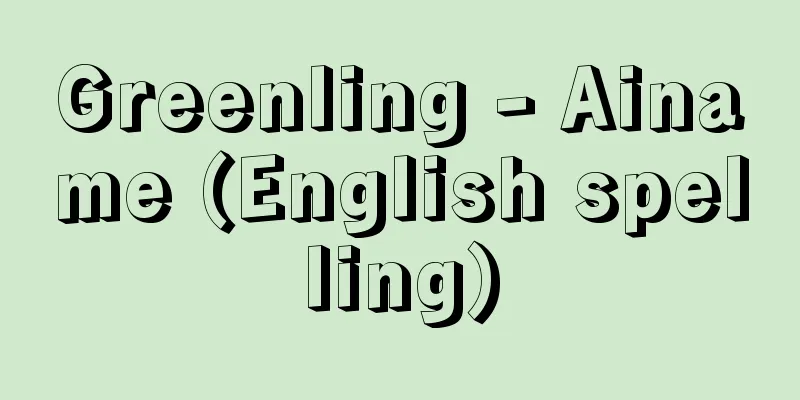Paper lantern - chochin

|
A lighting device for candles. It is a unique Japanese lighting device that has a frame made of split bamboo rolled into a spiral shape, paper pasted on it, a mouth ring on top and a bottom ring on the bottom, and can be folded up. In addition to being portable at night, it was used as an outdoor light and marker. It comes in a variety of shapes, including spherical, cylindrical, and natsume (jujube) shapes. In the olden days, it was written as "choto" and consisted of paper stretched over a wooden frame that was hung in one place like a hanging lantern, but eventually it became a basket with paper stretched over it and a handle attached for carrying it around, becoming a basket choto. Around the Tensho and Bunroku eras (1573-96), it became foldable and the character for chochin (paper lantern) was used to refer to it as a light that was carried in the hand. Choto means a light that is hung in one place, while chochin means a light that is carried around, which tells us the process by which this lighting device was developed. In the Edo period, it replaced the traditional andon (lantern) and became popular as a portable lighting device, leading to the creation of various types of chochin lanterns. Around this time, craftsmen appeared who would carry fire boxes and, upon request, instantly reupholster lanterns, paint family crests on lanterns, and apply paulownia oil to them. Lantern makers who specialized in producing and selling lanterns also appeared. There are many different sizes of lanterns, but the Hako lantern is made to fold up into a single box. It was initially used for general use, but then it became for ceremonies, and later it was used to welcome and send off customers in pleasure quarters, and it was also called Yoshiwara lantern or Yakko lantern. This is because it was used in Yoshiwara, or carried by samurai attendants to light the way. Odawara lanterns are said to have originated from Jinzaemon of Odawara in Sagami (Kanagawa Prefecture), and are small, lightweight, cylindrical lanterns that were used mainly for travel. They were widely sold as a specialty of Odawara from the Kyoho era (1716-36), and because they could be folded up and carried in the pocket, they were also called pocket lanterns or sleeve-drop lanterns. Hanging lanterns were crude, round or natsume-shaped lanterns that were carried around hanging from the end of a pole and were widely used by the general public, while the horse-riding lanterns used by samurai while riding on horseback were a higher-quality product. Small, red, red and white-coloured lanterns also belong to this type, and are still used today in decorations for festivals and celebrations, in lantern processions and in other events, and are exported overseas. Bow-hanging lanterns come in both round and cylindrical shapes, and both are stabilized by stretching the fire bag above and below using the elasticity of a bamboo bow. They were first used by samurai, but later came to be widely used by firemen, errand takers and other merchants. Takabari lanterns are large, natsume-shaped lanterns that are attached to the end of a long pole and hung by fastening a mouth ring and a bottom ring. These lanterns were inscribed with the family crest, the name of the family store, or other characters, and were hung high in front of the gates of temples and shrines, government offices, and in storefronts of merchants as gate lights, or at the head of a procession, where they were used as a kind of landmark. Hanging lanterns are larger than hanging lanterns, and were used as offerings to temples and shrines, or as sacred lanterns at festivals. Gifu lanterns are one type of hanging lantern, and are made in a variety of shapes and colors as Bon lanterns and decorative lanterns, and in recent years they have been actively exported overseas. Another outstanding invention from the Edo period was the portable searchlight, the gandou lantern. This was also written as gandou, and was also called shinobi lantern, and had an ingenious mechanism that ensured that the candle light would never go out, no matter how it was swung around, and it was used by spotters and others for nighttime searches. The process of making a lantern involves first fixing the top and bottom of eight to twelve blades in a vice to set up the shape, then cutting one end of a split bamboo diagonally to create a top edge, wrapping the split bamboo around the blade and fastening it with the top edge. Split bamboo comes in thin, medium, thick and extra thick varieties, and is used depending on the size of the lantern. Strands of cotton thread are tied between the bamboo, fixed in place, and then the threads are stretched. The bamboo is glued with a rice paste called sokui, paper is placed on top, sprayed with mist, and stretched every other ken. Family crests and characters are written on the bamboo, and sometimes oil is applied on top. A candle holder, a base ring, and other tools are attached before the lantern is completed. Currently, Gifu City and Yame City in Fukuoka Prefecture are famous for producing lanterns. [Mizuo Miyamoto] [Reference items] | | | |© Yoshiyasu Tanaka Main types of lanterns ©Kanagawa Prefecture Tourism Association "> Odawara Lanterns ©Gifu Prefecture "> Gifu Lantern Source: Shogakukan Encyclopedia Nipponica About Encyclopedia Nipponica Information | Legend |
|
ろうそく用灯火具。螺旋(らせん)状に巻いた割竹(ひご)を骨とし、これに紙を張り、上に口輪、下に底輪をつけて、折り畳みできるようにした日本独特の灯火具。夜間の携行用のほか、屋外の照明・目印としても用いた。形には球形、円筒形、棗(なつめ)形などいろいろある。 古くは「挑灯」と書き、木枠に紙を張り、吊灯籠(つりどうろう)のように一か所に掲げ置いたものであったが、やがて籠(かご)に紙を張り、携行用の取っ手をつけた籠(かご)挑灯となった。天正(てんしょう)・文禄(ぶんろく)(1573~96)のころには折り畳みできるものとなり、手に提げる灯火具ということから、提灯の文字があてられるようになった。挑灯は一か所に掲げ置く灯火、提灯は携えてゆく灯火の意で、この灯火具の発生過程を物語っているといえよう。これが江戸時代に入ると、在来の行灯(あんどん)にかわって、携行用灯火具として流行し、各種の提灯がつくりだされた。さらにこのころ、火袋(ひぶくろ)を携えて、客の求めに応じて、即時に提灯の張り替えや、提灯に家紋を描き、桐油(とうゆ)を引くなどする職人も現れ、また、その生産・販売を専業とする提灯屋も現れた。 提灯には大小いろいろあるが、筥(はこ)提灯は、折り畳むと1個の箱になるようにつくられ、初めは一般的に用いられたが、やがて儀式用となり、のちには遊里などで客の送迎に使用され、吉原提灯、奴(やっこ)提灯とも称された。それは、吉原で使われたり、武士の供をする奴が持って足元を照らすのに用いたためである。小田原(おだわら)提灯は、相州(神奈川県)小田原の甚左衛門がつくったのに始まるといわれ、円筒形の小形・軽便なもので、もっぱら旅行用とされた。享保(きょうほう)年間(1716~36)から小田原名物として広く売られ、畳んで懐(ふところ)に携帯できることから懐提灯・袂(たもと)落しとも称された。ぶら提灯は、棒の先端にぶら下げて持ち歩いた球形や棗形の粗末なもので、広く民衆の間に用いられたが、武士が馬乗りに用いた馬乗提灯はその上製品である。また赤・紅白など色彩を施した小形の酸漿(ほおずき)提灯もこの一種で、今日でも祭事・祝賀用の装飾や提灯行列などに用いられ、海外にも輸出されている。弓張(ゆみはり)提灯には、球形と円筒形のものがあるが、いずれも竹弓の弾力を利用して火袋を上下に張って安定させたもので、初め武士が使用したが、のちに火消し人足や御用聞きなど広く商家でも使用するようになった。高張提灯は、棗形の大形の提灯で、長竿(ながざお)の先端につけ、口輪と底輪を留めて張った。これには定紋(じょうもん)や屋号その他の文字が書かれ、社寺や役所の門前、商家の店頭などに高く掲げて門灯とし、また行列の先頭に掲げて、一種の目印としても利用された。吊(つり)提灯は、ぶら提灯より大形で、社寺への献灯や祭礼の御神灯(ごしんとう)として用いた。岐阜提灯もこの吊提灯の一種で、盆提灯や装飾用として種々の形態・色彩のものがつくられ、近年は海外への輸出も盛んになっている。このほか、江戸時代の優れた発明品の一つに、携行探照具の龕灯(がんどう)提灯がある。これは、強盗(がんどう)とも書き、一名忍び提灯ともいい、どのように振り回しても、ろうそくの明かりが絶対に消えない巧妙な機構になっており、目明(めあか)しなどが夜間の捜索に使用した。 提灯の製作工程は、まず八ないし12枚のハネの上下を万力で固定し型組みをし、次に割竹(ひご)の一端を斜めに削りクチガミをつけ、ハネにその割竹を巻き付け、クチガミで留める。割竹には、細・中太・太・極太があり、提灯の大きさによって使い分ける。割竹の間に木綿(もめん)糸を1本ずつからげ、これを固定し、糸張りをする。ソクイという米の糊(のり)で糊付けをし、これに紙をのせ、霧を吹いて、一間おきに張ってゆく。これに定紋や文字を書き、さらに上から油を塗ることもあり、ろうそく立て、底輪など道具付けをして完成する。現在、提灯の生産地としては、岐阜市と福岡県八女(やめ)市が名高い。 [宮本瑞夫] [参照項目] | | | |©田中淑安"> 提灯のおもな種類 ©公益社団法人神奈川県観光協会"> 小田原提灯 ©岐阜県"> 岐阜提灯 出典 小学館 日本大百科全書(ニッポニカ)日本大百科全書(ニッポニカ)について 情報 | 凡例 |
<<: Lantern anglerfish - lantern anglerfish (English spelling)
Recommend
Urihime - Urihime
...This is a folk tale with a girl born from a me...
Yu Ji
[Born] 1272 [Died] 1348 A Chinese literary figure ...
Konotegashiwa - This wrinkle
It is an evergreen shrub or small tree of the Cup...
Berserker
...At the end of the 16th century, a French hunte...
豨薟 - Menamomi
〘Noun〙 An annual plant of the Asteraceae family. I...
Cirque de Gavarnie
A cirque on the western slope (French side) of Mar...
Olcott, HS - Olcott
…The term “theosophy” is always used to describe ...
Anglo-Iranian Oil Company
→ British Petroleum [Company] Source : Heibonsha E...
No hunting zone - Kinryoku
Areas where hunting is prohibited in order to acti...
Ministry of Transport - Unyusho
A national administrative agency established by t...
Okunoshima - Okunoshima
Okunoshima is an island in the Geiyo Islands in t...
Panipat (English spelling)
...Three important battles in Indian history were...
burnet
...It is also used in flower arrangements, but is...
Stephan, H. von (English spelling) Stephan Hvon
…In order to coordinate basic matters and promote...
Coccidae
...A general term for insects in the order Hemipt...









